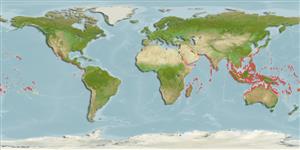Holothuroidea |
Holothuriida |
Holothuriidae
Environment: milieu / climate zone / depth range / distribution range
Ecology
Benthic; depth range 0 - 20 m (Ref. 81020). Tropical
Indo-West Pacific.
Length at first maturity / Size / Weight / Age
Maturity: Lm ? range ? - ? cm Max length : 35.0 cm TL male/unsexed; (Ref. 92930)
Found on sandy areas (Ref. 115900) surrounded by corals (Ref. 129602). During the day, this species is found under rubble on reef flats, while at night it starts being exposed and becoming active. Disturbance causes this species to eject copious amounts of Cuvierian tubules (Ref. 85218). Conveyor belt-feeder (Ref. 108108), meaning it ingests the substrate's surface and defecates on it (Ref. 115242). Inserts itself in cavities beneath coral colonies during the day along with other Holothuroids (Ref. 129602).
Life cycle and mating behavior
Maturity | Reproduction | Spawning | Eggs | Fecundity | Larvae
Members of the class Holothuroidea are gonochoric and have only one gonad. Spawning and fertilization are both external and some exhibit brooding. Life cycle: Embryos develop into planktotrophic larvae (auricularia) then into doliolaria (barrel-shaped stage) which later metamorphose into juvenile sea cucumbers.
Hartati, S.T., I.S. Wahyuni and U.N. Badri 2050 Jenis-Jenis Teripang Di Indonesia: Sea Cucumber species of Indonesia. Research Institute for Marine Fisheries. (Ref. 75656)
IUCN Red List Status
(Ref. 130435: Version 2025-1)
CITES status (Ref. 108899)
Not Evaluated
Not Evaluated
Threat to humans
Harmless
Human uses
Fisheries: commercial
| FishSource |
Tools
More information
Trophic EcologyFood items (preys)
Diet composition
Food consumption
Predators
Population dynamicsGrowthMax. ages / sizesLength-weight rel.Length-length rel.Length-frequenciesMass conversionAbundance Life cycleReproductionMaturityFecunditySpawningEggsEgg developmentLarvae PhysiologyOxygen consumption
Human RelatedStamps, coins, misc.
Internet sources
Estimates based on models
Preferred temperature
(Ref.
115969): 25.6 - 29.3, mean 28.7 (based on 2707 cells).
Fishing Vulnerability
Low vulnerability (25 of 100).
